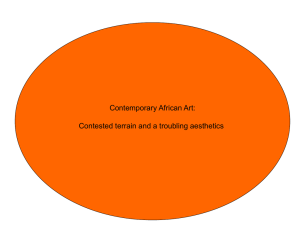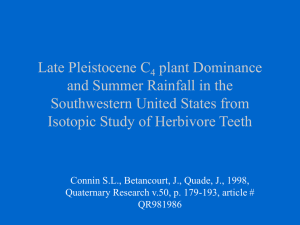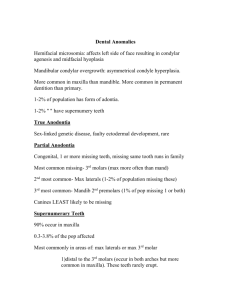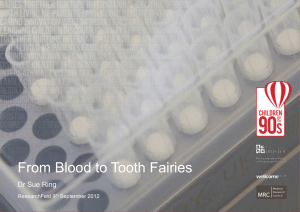Appendix 1
advertisement
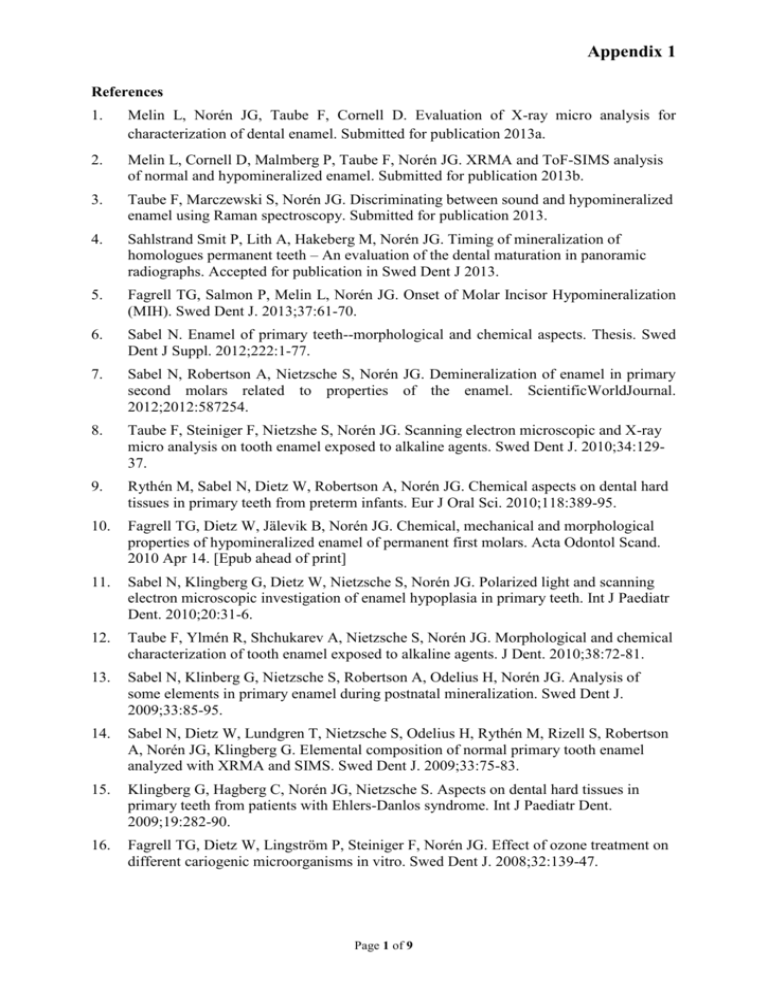
Appendix 1 References 1. Melin L, Norén JG, Taube F, Cornell D. Evaluation of X-ray micro analysis for characterization of dental enamel. Submitted for publication 2013a. 2. Melin L, Cornell D, Malmberg P, Taube F, Norén JG. XRMA and ToF-SIMS analysis of normal and hypomineralized enamel. Submitted for publication 2013b. 3. Taube F, Marczewski S, Norén JG. Discriminating between sound and hypomineralized enamel using Raman spectroscopy. Submitted for publication 2013. 4. Sahlstrand Smit P, Lith A, Hakeberg M, Norén JG. Timing of mineralization of homologues permanent teeth – An evaluation of the dental maturation in panoramic radiographs. Accepted for publication in Swed Dent J 2013. 5. Fagrell TG, Salmon P, Melin L, Norén JG. Onset of Molar Incisor Hypomineralization (MIH). Swed Dent J. 2013;37:61-70. 6. Sabel N. Enamel of primary teeth--morphological and chemical aspects. Thesis. Swed Dent J Suppl. 2012;222:1-77. 7. Sabel N, Robertson A, Nietzsche S, Norén JG. Demineralization of enamel in primary second molars related to properties of the enamel. ScientificWorldJournal. 2012;2012:587254. 8. Taube F, Steiniger F, Nietzshe S, Norén JG. Scanning electron microscopic and X-ray micro analysis on tooth enamel exposed to alkaline agents. Swed Dent J. 2010;34:12937. 9. Rythén M, Sabel N, Dietz W, Robertson A, Norén JG. Chemical aspects on dental hard tissues in primary teeth from preterm infants. Eur J Oral Sci. 2010;118:389-95. 10. Fagrell TG, Dietz W, Jälevik B, Norén JG. Chemical, mechanical and morphological properties of hypomineralized enamel of permanent first molars. Acta Odontol Scand. 2010 Apr 14. [Epub ahead of print] 11. Sabel N, Klingberg G, Dietz W, Nietzsche S, Norén JG. Polarized light and scanning electron microscopic investigation of enamel hypoplasia in primary teeth. Int J Paediatr Dent. 2010;20:31-6. 12. Taube F, Ylmén R, Shchukarev A, Nietzsche S, Norén JG. Morphological and chemical characterization of tooth enamel exposed to alkaline agents. J Dent. 2010;38:72-81. 13. Sabel N, Klinberg G, Nietzsche S, Robertson A, Odelius H, Norén JG. Analysis of some elements in primary enamel during postnatal mineralization. Swed Dent J. 2009;33:85-95. 14. Sabel N, Dietz W, Lundgren T, Nietzsche S, Odelius H, Rythén M, Rizell S, Robertson A, Norén JG, Klingberg G. Elemental composition of normal primary tooth enamel analyzed with XRMA and SIMS. Swed Dent J. 2009;33:75-83. 15. Klingberg G, Hagberg C, Norén JG, Nietzsche S. Aspects on dental hard tissues in primary teeth from patients with Ehlers-Danlos syndrome. Int J Paediatr Dent. 2009;19:282-90. 16. Fagrell TG, Dietz W, Lingström P, Steiniger F, Norén JG. Effect of ozone treatment on different cariogenic microorganisms in vitro. Swed Dent J. 2008;32:139-47. Page 1 of 9 Appendix 1 17. Rythén M, Norén JG, Sabel N, Steiniger F, Niklasson A, Hellström A, Robertson A. Morphological aspects of dental hard tissues in primary teeth from preterm infants. Int J Paediatr Dent. 2008;18:397-406. 18. Sabel N, Johansson C, Kühnisch J, Robertson A, Steiniger F, Norén JG, Klingberg G, Nietzsche S. Neonatal lines in the enamel of primary teeth—a morphological and scanning electron microscopic investigation. Arch Oral Biol. 2008;53:954-63. 19. Fagrell TG, Lingström P, Olsson S, Steiniger F, Norén JG. Bacterial invasion of dentinal tubules beneath apparently intact but hypomineralized enamel in molar teeth with molar incisor hypomineralization. Int J Paediatr Dent. 2008;18:333-40. 20. Heijs SC, Dietz W, Norén JG, Blanksma NG, Jälevik B. Morphology and chemical composition of dentin in permanent first molars with the diagnose MIH. Swed Dent J. 2007;31:155-64. 21. Youravong N, Teanpaisan R, Norén JG, Robertson A, Dietz W, Odelius H, Dahlén G. Chemical composition of enamel and dentine in primary teeth in children from Thailand exposed to lead. Sci Total Environ. 2008;389:253-8. 22. Youravong N, Chongsuvivatwong V, Teanpaisan R, Geater AF, Dietz W, Dahlén G, Norén JG. Morphology of enamel in primary teeth from children in Thailand exposed to environmental lead. Sci Total Environ. 2005;348:73-81. 23. Klingberg G, Dietz W, Oskarsdóttir S, Odelius H, Gelander L, Norén JG. Morphological appearance and chemical composition of enamel in primary teeth from patients with 22q11 deletion syndrome. Eur J Oral Sci. 2005;113:303-11. 24. Jälevik B, Dietz W, Norén JG. Scanning electron micrograph analysis of hypomineralized enamel in permanent first molars. Int J Paediatr Dent. 2005;15:233-40. 25. Bjarnason S, Dietz W, Hoyer I, Norén JG, Robertson A, Kraft U. Bonded resin sealant on smooth surface dental enamel--an in vitro study. Swed Dent J. 2003;27:167-74. 26. Klingberg G, Oskarsdóttir S, Johannesson EL, Norén JG. Oral manifestations in 22q11 deletion syndrome. Int J Paediatr Dent. 2002;12:14-23. 27. Jälevik B, Klingberg G, Barregård L, Norén JG. The prevalence of demarcated opacities in permanent first molars in a group of Swedish children. Acta Odontol Scand. 2001;5:255-60. 28. Jälevik B, Norén JG, Klingberg G, Barregård L. Etiologic factors influencing the prevalence of demarcated opacities in permanent first molars in a group of Swedish children. Eur J Oral Sci. 2001;109:230-4. 29. Jälevik B, Norén JG. Enamel hypomineralization of permanent first molars: a morphological study and survey of possible aetiological factors. Int J Paediatr Dent. 2000;10:278-89. 30. Robertson A, Andreasen FM, Andreasen JO, Norén JG. Long-term prognosis of crownfractured permanent incisors. The effect of stage of root development and associated luxation injury. Int J Paediatr Dent. 2000;10:191-9. 31. Jälevik B, Odelius H, Dietz W, Norén J. Secondary ion mass spectrometry and X-ray microanalysis of hypomineralized enamel in human permanent first molars. Arch Oral Biol. 2001;46:239-47. Page 2 of 9 Appendix 1 32. Nilsson T, Lundgren T, Odelius H, Jönsson U, Sillén R, Norén JG. Differences in covariation of inorganic elements in the bulk and surface of human deciduous enamel: an induction analysis study. Connect Tissue Res. 1998;38:81-9; discussion 139-45. 33. Lindau BM, Dietz W, Hoyer I, Lundgren T, Storhaug K, Norén JG. Morphology of dental enamel and dentine-enamel junction in osteogenesis imperfecta. Int J Paediatr Dent. 1999;9:13-21. 34. Lundgren T, Persson LG, Engström EU, Chabala J, Levi-Setti R, Norén JG. A secondary ion mass spectroscopic study of the elemental composition pattern in rat incisor dental enamel during different stages of ameloblast differentiation. Arch Oral Biol. 1998;43:841-8. 35. Alexandersen V, Norén JG, Hoyer I, Dietz W, Johansson G. Aspects of teeth from archaelogic sites in Sweden and Denmark. Acta Odontol Scand. 1998;56:14-9. 36. Robertson A, Lundgren T, Andreasen JO, Dietz W, Hoyer I, Norén JG. Pulp calcifications in traumatized primary incisors. A morphological and inductive analysis study. Eur J Oral Sci. 1997;105:196-206. 37. Robertson A, Andreasen FM, Bergenholtz G, Andreasen JO, Norén JG. Incidence of pulp necrosis subsequent to pulp canal obliteration from trauma of permanent incisors. J Endod. 1996;22:557-60. 38. Teivens A, Mörnstad H, Norén JG, Gidlund E. Enamel incremental lines as recorders for disease in infancy and their relation to the diagnosis of SIDS. Forensic Sci Int. 1996;81:175-83. 39. Ranggård L, Ostlund J, Nelson N, Norén JG. Clinical and histologic appearance in enamel of primary teeth from children with neonatal hypocalcemia induced by blood exchange transfusion. Acta Odontol Scand. 1995;53:123-8. 40. Ranggård L, Norén JG, Nelson N. Clinical and histologic appearance in enamel of primary teeth in relation to neonatal blood ionized calcium values. Scand J Dent Res. 1994;102:254-9. 41. Ranggård L, Norén JG. Effect of hypocalcemic state on enamel formation in rat maxillary incisors. Scand J Dent Res. 1994;102:249-53. 42. Varpio M, Norén JG. Artificial caries in primary and permanent teeth adjacent to composite resin and glass ionomer cement restorations. Pediatr Dent. 1994;16:107-9. 43. Gängler P, Norén JG, Hoyer I, Bjarnason S, Kraft U, Odelius H, Wucherpfennig G. Reactivity of young and old human enamel to demineralization. Scand J Dent Res. 1993;101:345-9. 44. Norén JG, Ranggård L, Klingberg G, Persson C, Nilsson K. Intubation and mineralization disturbances in the enamel of primary teeth. Acta Odontol Scand. 1993;5:271-5. 45. Bäckman B, Lundgren T, Engström EU, Falk LK, Chabala JM, Levi-Setti R, Norén JG. The absence of correlations between a clinical classification and ultrastructural findings in amelogenesis imperfecta. Acta Odontol Scand. 1993;51:79-89. 46. Lundgren T, Westphal O, Bolme P, Modéer T, Norén JG. Retrospective study of children with hypophosphatasia with reference to dental changes. Scand J Dent Res. 1991;99:357-64. Page 3 of 9 Appendix 1 47. Lundin SA, Norén JG. Marginal leakage in occlusally loaded, etched, class-II composite resin restorations. Acta Odontol Scand. 1991;49:247-54. 48. Ranggård L, Norén JG, Engström C. Parathyroid hormone and enamel formation in rat maxillary incisors. Scand J Dent Res. 1991;99:90-5. 49. Varpio M, Warfvinge J, Norén JG. Proximo-occlusal composite restorations in primary molars: marginal adaptation, bacterial penetration, and pulpal reactions. Acta Odontol Scand. 1990;48:161-7. 50. Lundin SA, Norén JG, Warfvinge J. Marginal bacterial leakage and pulp reactions in Class II composite resin restorations in vivo. Swed Dent J. 1990;14:185-92. 51. Raether D, Klingberg G, Magnusson L, Norén JG. Histology of primary incisor enamel in children with early onset celiac disease. Pediatr Dent. 1988;10:301-3. 52. Chabala JM, Edward S, Levi-Setti R, Lodding A, Lundgren T, Norén JG, Odelius H. Elemental imaging of dental hard tissues by secondary ion mass spectrometry. Swed Dent J. 1988;12:201-12. 53. Malmberg E, Norén JG, Mellstrand T, Koch G. Fluorine uptake in bovine enamel from various treatment agents. Swed Dent J. 1987;11:263-71. 54. Norén JG, Hulthe P, Gillberg C. Analysis of lead and cadmium in deciduous teeth by means of potentiometric stripping analysis. Swed Dent J. 1987;11:45-52. 55. Norén JG, Gillberg C. Mineralization disturbances in the deciduous teeth of children with so called minimal brain dysfunction. Swed Dent J. 1987;11:37-43. 56. Engstrom C, Noren JG. Effects of orthodontic force on enamel formation in normal and hypocalcemic rats. J Oral Pathol. 1986;1:78-82. 57. Norén JG. Microscopic study of enamel defects in deciduous teeth of infants of diabetic mothers. Acta Odontol Scand. 1984;42:153-6. 58. Norén JG, Odelius H, Rosander B, Linde A. SIMS analysis of deciduous enamel from normal full-term infants, low birth weight infants and from infants with congenital hypothyroidism. Caries Res. 1984;18:242-9. 59. Norén JG. Enamel structure in deciduous teeth from low-birth-weight infants. Acta Odontol Scand. 1983;41:355-62. Page 4 of 9 Appendix 1 Thesis with connection to the Department of Pediatric Dentistry Norén JG. Human deciduous enamel in perinatal disorders. Morphological and chemical aspects. (198302-04) Abstract Polarization microscopy, microradiography and ion probe (SIMS) analysis are useful methods for investigations of normal and pathological deciduous enamel. New techniques for the ion probe studies in ground sections of dental hard tissues were developed and used for two-dimensional mapping and correlation analysis of the elemental distribution. It was shown that the prevalence of enamel hypoplasia was about the same in normal fullterm infants and low birth weight infants. The occurrence of enamel hypoplasias within the LBW group could be related to the breast milk intake during first week of life, with a low intake among infants with enamel hypoplasias. A seasonal variation seemed also to be of importance. The histological appearance and the elemental concentrations did not differ considerably between the specimens from normal full-term infants and from the LBW group. A subgroup of the LBW group, subjected to an increase in breast milk feeding during first year week of life, showed more similarities to the normal in the SIMS analysis than did the other LBW group. This implies a nutritional influence on the maturation of the deciduous enamel. Enamel from infants of diabetic mothers (IDM) showed widened neonatal lines. However, except for this morphological distinction they could not be discerned from normal. The SIMS analysis was conducted as a pilot study and failed to reveal any unequivocal difference. The possibility of neonatal hypocalcemia as an etiological factor behind the neonatal line and enamel hypoplasias found among the LBW infants and the IDM infants, was supported by the clinical and histological findings. Teeth from infants with congenital hypothyroidism (CH) differed both morphologically and chemically from teeth of normal full-term infants. This was taken as an evidence for the importance of the thyroid hormone for enamel formation. It is evident that morphological and chemical analyses of deciduous can provide considerable information as to how perinatal disorders may influence the formation of of deciduous enamel. The present study shows that deciduous enamel is not too sensitive to disturbances during its formation with the exceptions for hypocalcemia, as reflected in the presence of the neonatal line and enamel hypoplasias, and thyroid hormone deficiency, as reflected in a delayed enamel maturation. Lundin SA. Studies on posterior composite resins with special reference to class II restorations. (1990-1123) Abstract Longevity, clinical performance and some related factors of posterior composite resin restorations were investigated through clinical follow-up and laboratory studies in vivo and in vitro. Class I and Class II restorations using two experimental posterior composite resin materials were followed clinically for a four-year period. USPHS evaluation criteria were used. Assessments of wear were also made indirectly using the Leinfelder method. Marginal leakage of bacteria (in vivo) and of dye (in vitro) were studied on modified loaded Class II composite resin restorations lined with GlumaR and LifeR. The grade of conversion (cure) of the posterior composite resin material and the colonization of bacteria at proximal tooth surfaces restored with posterior composite resins were evaluated. Seven per cent of the restorations were evaluated as failures and had to be replaced during a 4-year period. The failures were mainly due to fractures and postoperative sensitivity. The calculated occlusal wear rate was 34-40 microns/year. Occlusal loading of Class II restorations in vitro resulted in a higher frequency of restorations with marginal leakage. The marginal leakage for occlusally-loaded Class II restorations in vivo and in vitro could be reduced if dentine bonding was utilized. The grade of conversion (cure) was increased in the in vivo situation compared to the in vitro. Bacterial colonization of strepococcus mutans on the proximal surfaces of posterior composite restorations showed higher frequencies compared to that on sound tooth surfaces. From the results of these studies, it may be concluded that the tested posterior composite resin materials can be used in Class I and II restorations with a good prognosis for at least 4 years. When posterior composite resins are used as restorative for posterior teeth, the following conditions should be considered: The occlusal loading should be minimal, dentin bonding should be used, the increased risk of colonization of streptococcus mutans should be acted on and regular clinical and radiographical follow-up should be performed. Page 5 of 9 Appendix 1 Varpio M. Clinical aspects of restorative treatment in the primary dentition. (1993-12-10) Abstract The failure rate of restorative treatment in primary teeth was studied in a cohort of children born in 1981 and related to caries diagnosis, prevalence and distribution on different tooth surfaces, and compared with a cohort of children born in 1971. Concurrently, the longevity of composite resin in modified Class 2 cavities in primary molars was followed up and the resistance of deciduous and permanent enamel to acid adjacent to composite resin and glass polyalkeonate cement (GPA) was tested in vitro. From the 70s to the 80s, diagnostic methods changed and the examination intervals were prolonged. The number of bite-wing radiographs was halved and the participation in all six annual examinations decreased from 89% to 32%. Caries prevalence increased from 1.1 ds in 3-year-olds to 6.3 ds in 8-year-olds in Cohort '71 and, in the same ages, from 0.2 ds to 3.0 in Cohort '81. In Cohort '81, an overall decline of occlusal caries was recorded. The distal surface of the first molars was the proximal surface most often affected in both cohorts. In Cohort '81, 30% had caries-free primary teeth at the age of 8, which can be compared with 17% in the cohort 10 years earlier. In Cohort '81, the proportion of replaced proximal restorations was 14% and that of extracted molars 2%. The corresponding figures for Cohort '71 were 17% and 4%, respectively. In Cohort '81, silver amalgam was used in 65% and GPA cements in 35%. On all surfaces, silver amalgam was replaced in 22% and GPA cements in 6%. Composite resin in modified Class 2 cavities showed a cumulative success rate that declined from 86% after one year to 38% after six years. Fractures occurred early and recurrent caries was found from the second year of the follow-up. Histological investigation of these teeth disclosed bacteria subjacent to the fillings in 75% and recurrent caries in 58%. The restorations in teeth with bacterial invasion showed marginal discolouration, visible crevices or colour mismatch. In an acid environment, the enamel showed artificial caries lesions adjacent to composite resin significantly more often in primary teeth than in permanent teeth. No lesions were seen close to GPA fillings in primary teeth. The improved dental health appeared to be of greater benefit to the children and care-providers than advances in restorative treatment. The properties of GPA cements seem useful in the restorative treatment of primary teeth. Ranggård L. Dental enamel in relation to ionized calcium and parathyroid hormone. Studies of human primary teeth and rat maxillary incisors. (1994-12-22) Abstract The aims of this thesis were to evaluate the role of lowered calcium values in blood on enamel formation and mineralization, and further to analyze whether the calcium regulating parathyroid hormone (PTH) would have any effects on the forming and mineralizing enamel. DENTAL ENAMEL AND IONIZED CALCIUM: Human primary teeth from two groups of infants were clinically and histologically examined. One group (n = 25) was born with optimal perinatal conditions. The infants had low, but not hypocalcemic values on day 1 when compared with days 3 and 5 postpartum. The second group of infants (n = 11) was subjected to blood exchange transfusion on the first few days postpartum. All infants developed very low values of blood ionized calcium due to the treatment, and the infants had a mean of three hypocalcemic days. Enamel aberrations were seen in both groups, but only four infants had multiple enamel aberrations located at levels corresponding to the enamel development at the time of the birth. Low values of blood ionized calcium alone were not associated with enamel aberrations, as the aberrations were only seen in infants subjected to more than three blood exchange transfusions. The neonatal line was present in all teeth investigated, thin lines dominated, and the widths were not dependent on the levels of blood ionized calcium during the first few days after birth. Rats were also used to investigate whether the maxillary incisor enamel would be affected during a diet-induced hypocalcemic state. Of ten experimental rats, nine had normal enamel, indicating that hypocalcemia in rats does not generally affect the enamel. DENTAL ENAMEL AND PARATHYROID HORMONE: Rats was used in a study where they were subjected to daily injections of PTH. Three different doses were used and the experimental periods were 7 and 14 days. In a pilot part, enamel aberrations were seen but not in the main study performed later. The main difference in experimental design between the pilot and the main part of the study was the use of hard tissue marker, oxytetracycline, at start of the pilot part. For this reason, a separate study was performed to evaluate the use of oxytetracycline in hard tissue research. The results clearly demonstrated that oxytetracycline itself induces enamel aberrations and so it was not used in the main study of parathyroid hormone. As no enamel aberrations were seen in the main part, it was concluded that the doses of PTH used do not seem to affect enamel formation and mineralization. Page 6 of 9 Appendix 1 Robertson A. Pulp survival and hard tissue formation subsequent to dental trauma. A clinical and histological study of uncomplicated crown fractures and luxation injuries. (1997-12-12) Abstract Traumatic injuries in children and adolescents are a common problem, and the prevalence of such injuries has increased over the last 10-20 years. The purpose of the present investigation was to evaluate long-term results following uncomplicated crown fractures and luxations involving subsequent pulp canal obliteration. A total of 198 patients with 488 injured permanent teeth were available for clinical examination (15 year follow-up), of which 102 also answered a questionnaire and were interviewed before oral examination. Further, 82 permanent incisors presenting with pulp canal obliteration (PCO) were followed for a period of 7 to 22 yr. (mean 16 yr.). The histological evaluation of luxation injuries was performed on 123 primary teeth from 98 patients. In the experimental study (crown fractures), 64 monkey permanent maxillary and mandibular central incisors and canines were subjected to different treatment alternatives at the time of fracture. The findings in the follow-up study showed very little pulpal response to crown fracture and subsequent restorative procedures as long as there was no concomitant periodontal injury. Approximately every fourth resin composite restoration was rated unacceptable at the clinical examination. The interview showed that half of the individuals were dissatisfied with the color and/or anatomic form of the composite restoration. PCO was found in all luxation categories, and according to the survival curve, the 20-year pulp survival rate diagnosed with X-ray was 84%. Although the risk for pulp necrosis (PN) increased with time, routine endodontic intervention of teeth with ongoing PCO of the root canal did not seem justified. The histological study showed that changes in dentin were represented by occlusion of the dentinal tubules and deposition of tertiary dentin. The tertiary dentin were classified as either dentin-like, bone-like or fibrotic. In the experimental study, few changes were observed in the pulp 3 months after crown fractures, irrespective of treatment alternative. Jälevik B. Enamel hypomineralization in permanent first molars. A clinical, histo-morphological and biochemical study. (2001-09-28) Abstract Hypomineralization in the permanent first molars was common in a group of 516 Swedish 8-year-old children. Ninety-five children (18.4%) had at least one molar with demarcated opacity. The incisors frequently displayed opacities concomitantly. The mean number of hypomineralized teeth of the affected children was 3.2 (SD 1.8), of which 2.4 were first molars. Six and a half percent of the children had severe defects, 5% had moderate defects, while 7% had only mildly hypomineralized teeth. Fifteen percent had more than one tooth affected, indicating systemic causation. The affected children, especially the boys, were reported to have had more health problems, asthma in particular (but only 4 cases), during the first year of life. Breast feeding history was similar in children with and without enamel defects. The children with severely defected enamel had undergone dental treatment of their first molars nearly ten times as often as the children in the healthy control group at the age of nine. Behavior management problems and dental fear and anxiety were common compared to the controls. Undemineralized sections from 73 permanent first molars, extracted due to severe hypomineralization of the enamel, were examined in polarized light. The hypomineralized areas extended from the cusps cervically comprising about half of the buccal and lingual sides. The cervical border to normal enamel was well defined and mainly followed the lines of Hunter-Schreger. The hypomineralized zones were covered by thin wellmineralized enamel. The concentration gradients for F, Cl, Na, Mg, K and Sr in hypomineralized enamel were analyzed by means of Secondary Ion Mass Spectrometry (SIMS), and completed with an analysis of the main matrix elements O, P and Ca by means of X-ray microanalysis (XRMA). Hypomineralized enamel had a higher content of C. Ca and P concentration were lower compared with normal enamel. The mean Ca/P ratio in hypomineralized areas was significantly lower (1.4) than the mean Ca/P ratio in the adjacent normal enamel (1.8). Page 7 of 9 Appendix 1 Fagrell T. Molar incisor hypomineralization. Morphological and chemical aspects, onset and possible etiological factors. (2011-12-02) Abstract The general objective of this thesis was to enhance the understanding of Molar Incisor Hypomineralization (MIH) in areas of the histological, chemical and mechanical properties of the hypomineralized enamel, objective and subjective clinical symptoms in relation to bacteria findings. Further, to estimate a time for onset of the disturbance and investigate possible etiological factors. 22 teeth diagnosed with MIH were used in the histological and chemical studies. A number of analytical methods were used; Light microscopy, Polarized light microscopy, Scanning electron microscopy, X-ray microanalysis, Vickers hardness test and X-ray Micro Computed Tomography. Decalcified sections were stained with bacterial staining. An ozone device was tested for the ability to kill strains of oral bacteria. In collaboration with the prospective ABIS study, 17.000 individuals were examined and possible etiological causes of severe demarcated opacities were tested. The hypomineralized enamel was mainly located in the buccal enamel of the teeth and had a high degree of porosity extending from enamel-dentin-junction with a distinct border to the normal cervical enamel. Teeth diagnosed MIH had lower hardness values in hypomineralized enamel and differences in the chemical composition. Bacteria were observed in the enamel and deep into the dentin. Ozone treatment for 20 seconds or more was effective to kill oral microorganisms. Significant relations were found between MIH in first molars and breast feeding more than 6 months, late introduction to gruel and infant formula (later than 6 months). The onset for the hypomineralized enamel was estimated to around 200 days from start of the enamel mineralization. Sabel N. Enamel of primary teeth--morphological and chemical aspects. (2012-03-02) Abstract Enamel is one of the most important structures of the tooth, both from a functional and esthetic point of view. Primary enamel carries registered information regarding metabolic and physiological events that occurred during the period around birth and the first year of life. Detailed knowledge of normal development and the structure of enamel is important for the assessment of mineralization defects. The aim of the thesis is to add more detailed information regarding the structure of primary enamel. The structural appearance of the neonatal line and the quantitative developmental enamel defect, enamel hypoplasia, was thoroughly investigated with a polarized light microscope, microradiography and scanning electron microscope. X-ray microanalysis of some elements was also performed across the enamel and the neonatal line. Postnatal mineralization of enamel at different ages and from different individuals was studied regarding the chemical content, by using secondary ion mass spectrometry. The enamel's response to demineralization was investigated in relation to the individual chemical content and the degree of mineralization of the enamel, by using polarized light microscope, microradiography, scanning electron microscope and X-ray microanalysis. The neonatal line is a hypomineralized structure seen as a step-like rupture in the enamel matrix. The neonatal line is due to disturbances in the enamel secretion stage. The enamel prisms in the postnatal enamel appeared to be smaller than the prenatal prisms. The hypoplasias showed a rough surface at the base and no aprismatic surface layer was seen in the defect. The enamel of the rounded border of hypoplasia appeared to be hypomineralized, with the bent prisms not being densely packed. Mineralization of enamel is a gradual process, still continuous at 6 months postnatally in the primary mandibular incisors. The thickness of the buccal enamel is reached at 3-4 months of age. Demineralization of enamel depends on the degree of mineralization and the chemical content of the enamel exposed. In a more porous enamel, deeper lesions will develop. The posteruptive maturation has a beneficial effect on the enamel's resistance to demineralization. Page 8 of 9 Appendix 1 Rythén M. Preterm infants--odontological aspects. (2012-05-04) Abstract Preterm birth is associated with medical complications and treatments postnatally and disturbances in growth and development. Primary and permanent teeth develop during this postnatal period. The overall aim of the present thesis was to elucidate the effects of preterm birth and postnatal complications on oral health and the dentoalveolar development during adolescence, and to study the effects of preterm birth on caries during childhood, in a well-defined group of preterm infants. In the same group, explore the development of the primary and permanent teeth and compare the results with a matched control group and control teeth. The subjects consisted of 40 (45) of 56 surviving infants, born < 29 weeks of gestational age (GA), and matched healthy children born at term. The material consisted of 44 teeth from 14 of the preterm adolescents and 36 control teeth from healthy children. Clinical examinations and dental cast analysis were performed during adolescence and morbidity was noted. Retrospective information from medical and dental records was obtained. Dental enamel was analyzed in a polarized light microscopy, and scanning electron microscopy. Further, chemical analyses of enamel and dentin were performed with X-ray microanalysis. The results showed that during adolescence, more preterms had plaque and gingival inflammation, lower salivary secretion, more S. mutans and severe hypomineralization. Retrospectively, less caries was noted at six years of age, but more children had hypomineralization in the primary dentition. Angle Class II malocclusion, large over-bite and deep bite associated with medical diagnoses were frequent. Furthermore, smaller dental arch perimeters in girls, at 16 years of age, and smaller tooth size in the incisors, canines and first molars were found. The morphological findings were confirmed in the XRMA analyses. In postnatal enamel, varying degrees of porosities > 5% and incremental lines were seen. Lower values of Ca and Ca/C ratio and higher values of C were found. Ca/P ratio in both enamel and dentine indicates normal hydroxyapatite in both groups. No single medical diagnosis, postnatal treatment or morbidity in adolescents could explain the findings. As a conclusion, there are indications for poor oral outcome in this group of preterm infants during adolescence, and disturbed mineralization in primary teeth. Page 9 of 9
